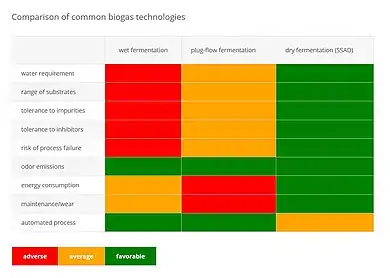Anaerobic digester types
The following is a partial list of types of anaerobic digesters. These processes and systems harness anaerobic digestion for purposes such as treatment of biowaste, animal manure, sewage and biogas generation.[1] Anaerobic digesters can be categorized according to several criteria: by whether the biomass is fixed to a surface ("attached growth") or can mix freely with the reactor liquid ("suspended growth"); by the organic loading rate (the influent mass rate of chemical oxygen demand per unit volume);[2] by centralized plants and decentralized plants.[3] Most anaerobic digesters worldwide are built based on wet-type anaerobic digestion, wherein biomass (usually animal dung) and water are mixed in equal amounts to form a slurry in which the content of total solids (TS) is about 10-15%. While this type is suitable for most regions, it becomes a challenge in large plants where it necessitates the use of large quantities of water every day, often in water-scare areas.[4] Solid-state type digesters, as opposed to the wet-type digesters, reduces the need to dilute the biomass before using it for digestion. solid-state type digesters can handle dry, stackable biomass with a high percentage of solids (up to 40%), and consists of gas-tight chambers called fermenter boxes working in batch-mode that are periodically loaded and unloaded with solid biomass and manure.[5] The widely used UASB reactor, for example, is a suspended-growth high-rate digester, with its biomass clumped into granules that will settle relatively easily and with typical loading rates in the range 5-10 kgCOD/m3/d.[2]

Most common types of anaerobic digestion are liquid, plug-flow and solid-state type digesters.[6]
Examples of anaerobic digesters include:
- Anaerobic activated sludge process
- Anaerobic clarigester
- Anaerobic contact process
- Anaerobic expanded-bed reactor
- Anaerobic filter
- Anaerobic fluidised bed
- Anaerobic lagoon
- Anaerobic MBRs
- Anaerobic migrating blanket reactor
- Batch system anaerobic digester
- Continuous stirred-tank reactor (CSTR)
- Expanded granular sludge bed digestion (EGSB)
- Hybrid reactor
- Imhoff tank
- Internal circulation reactor (IC)
- One-stage anaerobic digester
- Plug-flow anaerobic digester
- Submerged media anaerobic reactor
- Sintex Digester
- Solid-state anaerobic digester (SSAD)
- Two-stage anaerobic digester
- Upflow anaerobic sludge blanket digestion (UASB)
- Upflow and down-flow anaerobic attached growth
References
- "BIOGAS AND ANAEROBIC DIGESTION: Fundamentals and Applications" (PDF). The Global Climate and Energy Project (GCEP) at Stanford University.
- Grant, Shannon R.; Shashi Gorur; James C. Young; Robert Landine; Albert C. Cocci; C. Calvert Churn (November 2002). "An Anaerobic Exercise: A comparison of anaerobic treatment technologies for industrial wastewater". Environmental Protection: 18–26. Retrieved 4 Jan 2013.
- Agali, Chiamaka (2018). "Overview of Biogas Production". Stanford University.
- "War on India's Toxic Pollution". Renewable Energy World. 2020.
- Zhou, Haoqin (January 2019). "Solid-State Anaerobic Digestion for Waste Management and Biogas Production". ResearchGate.
- "Types of anaerobic digester". ResearchGate. January 2002.
